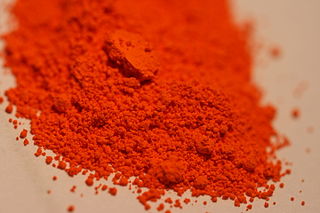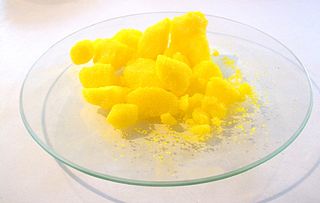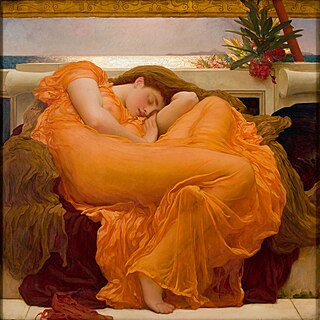Related Research Articles

Acrylic paint is a fast-drying paint made of pigment suspended in acrylic polymer emulsion and plasticizers, silicone oils, defoamers, stabilizers, or metal soaps. Most acrylic paints are water-based, but become water-resistant when dry. Depending on how much the paint is diluted with water, or modified with acrylic gels, mediums, or pastes, the finished acrylic painting can resemble a watercolor, a gouache, or an oil painting, or it may have its own unique characteristics not attainable with other media.

Chromium is a chemical element; it has symbol Cr and atomic number 24. It is the first element in group 6. It is a steely-grey, lustrous, hard, and brittle transition metal.

Paint is a liquid pigment that, after applied to a solid material and allowed to dry, adds a film-like layer. As art, this is used to create an image, known as a painting. Paint can be made in many colors and types. Most paints are either oil-based or water-based, and each has distinct characteristics.

A pigment is a powder used to add color or change visual appearance. Pigments are completely or nearly insoluble and chemically unreactive in water or another medium; in contrast, dyes are colored substances which are soluble or go into solution at some stage in their use. Dyes are often organic compounds whereas pigments are often inorganic. Pigments of prehistoric and historic value include ochre, charcoal, and lapis lazuli.

Cadmium pigments are a class of pigments that contain cadmium. Most of the cadmium produced worldwide has been for use in rechargeable nickel–cadmium batteries, which have been replaced by other rechargeable nickel-chemistry cell varieties such as NiMH cells, but about half of the remaining consumption of cadmium, which is approximately 2,000 tonnes annually, is used to produce colored cadmium pigments. The principal pigments are a family of yellow, orange and red cadmium sulfides and sulfoselenides, as well as compounds with other metals.

Chromate salts contain the chromate anion, CrO2−
4. Dichromate salts contain the dichromate anion, Cr
2O2−
7. They are oxyanions of chromium in the +6 oxidation state and are moderately strong oxidizing agents. In an aqueous solution, chromate and dichromate ions can be interconvertible.

Anti-fouling paint is a specialized category of coatings applied as the outer (outboard) layer to the hull of a ship or boat, to slow the growth of and facilitate detachment of subaquatic organisms that attach to the hull and can affect a vessel's performance and durability. It falls into a category of commercially available underwater hull paints, also known as bottom paints.
School bus yellow is a color that was specifically formulated for use on school buses in North America in 1939. Originally officially named National School Bus Chrome, the color is now officially known in Canada and the U.S. as National School Bus Glossy Yellow.

Aerosol paint is paint that comes in a sealed, pressurized container and is released in an aerosol spray when a valve button is depressed. The propellant is what the container of pressurized gas is called. When the pressure holding the gas is released through the valve, the aerosol paint releases as a fine spray. Aerosol painting is one form of spray painting; it leaves a smooth, even coat, unlike many traditional rolled and brushed paints. Aerosol primer can be applied directly to bare metal and many plastics.

Lead(II,IV) oxide, also called red lead or minium, is the inorganic compound with the formula Pb3O4. A bright red or orange solid, it is used as pigment, in the manufacture of batteries, and rustproof primer paints. It is an example of a mixed valence compound, being composed of both Pb(II) and Pb(IV) in the ratio of two to one.
Chrome yellow is a bright, warm yellow pigment that has been used in art, fashion, and industry. It is the premier orange pigment for many applications.

A primer or undercoat is a preparatory coating put on materials before painting. Priming ensures better adhesion of paint to the surface, increases paint durability, and provides additional protection for the material being painted.

Lead paint or lead-based paint is paint containing lead. As pigment, lead(II) chromate, lead(II,IV) oxide,, and lead(II) carbonate are the most common forms. Lead is added to paint to accelerate drying, increase durability, maintain a fresh appearance, and resist moisture that causes corrosion. It is one of the main health and environmental hazards associated with paint. Lead paint has been generally phased out of use due to the toxic nature of lead. Alternatives such as water-based, lead-free traffic paint are readily available.

Hexavalent chromium (chromium(VI), Cr(VI), chromium 6) is any chemical compound that contains the element in the +6 oxidation state (thus hexavalent). It has been identified as carcinogenic, which is of concern since approximately 136,000 tonnes (150,000 tons) of hexavalent chromium were produced in 1985. Hexavalent chromium compounds can be carcinogens (IARC Group 1), especially if airborne and inhaled where they can cause lung cancer.

Zinc chromate, ZnCrO4, is a chemical compound, a salt containing the chromate anion, appearing as odorless yellow powder or yellow-green crystals, but, when used for coatings, pigments are often added. It is used industrially in chromate conversion coatings, having been developed by the Ford Motor Company in the 1920s.

Lead(II) chromate is an inorganic compound with the chemical formula PbCrO4. It has a vivid yellow color and is generally insoluble. Two polymorphs of lead chromate are known, orthorhombic and the more stable monoclinic form. Monoclinic lead chromate is used in paints under the name chrome yellow, and many other names. It occurs also as the mineral crocoite.

Chrome orange is a mixed oxide with the chemical formula Pb2CrO5. It can be made by treating a lead(II) salt with an alkaline solution of a chromate or by treating chrome yellow (PbCrO4) with strongly basic solution.

White lead is the basic lead carbonate 2PbCO3·Pb(OH)2. It is a complex salt, containing both carbonate and hydroxide ions. White lead occurs naturally as a mineral, in which context it is known as hydrocerussite, a hydrate of cerussite. It was formerly used as an ingredient for lead paint and a cosmetic called Venetian ceruse, because of its opacity and the satiny smooth mixture it made with dryable oils. However, it tended to cause lead poisoning, and its use has been banned in most countries.

The environmental effects of paint can vary depending on the type of paint used and mitigation measures. Traditional painting materials and processes can have harmful effects on the environment, including those from the use of lead and other additives. Measures can be taken to reduce its environmental effects, including accurately estimating paint quantities so waste is minimized, and use of environmentally preferred paints, coating, painting accessories, and techniques.
Chromium toxicity refers to any poisonous toxic effect in an organism or cell that results from exposure to specific forms of chromium—especially hexavalent chromium. Hexavalent chromium and its compounds are toxic when inhaled or ingested. Trivalent chromium is a trace mineral that is essential to human nutrition. There is a hypothetical risk of genotoxicity in humans if large amounts of trivalent chromium were somehow able to enter living cells, but normal metabolism and cell function prevent this.
References
- 1 2 "Property: Call time on heavy metal poisoning - Business, News". The Independent. 1998-02-15. Retrieved 2011-08-06.
- ↑ "Lead in Paint - Brushed Aside? - Johnson et al. 104 (2): 64 - Perspectives in Public Health". Rsh.sagepub.com. Archived from the original on 2012-07-14. Retrieved 2011-08-06.
- ↑ "Council Directive 89/677/EEC", The Council of the European Communities, 21 December 1989. Retrieved on 2015-07-20.
- 1 2 "The Environmental Protection (Controls on Injurious Substances) Regulations 1992", UK Government Statutory Instruments 1992 No. 31, 9 January 1992. Retrieved on 2015-07-20.
- ↑ "REACH Legislation", European Chemicals Agency . Retrieved 2015-07-20.
- ↑ "Technical Q&A 30: Lead Paint", SPSB, London, 2007. Retrieved on 2015-07-20.
- ↑ "Technical Issues: Red Oxide" Archived 2015-07-31 at the Wayback Machine , Highland Colour Coaters Ltd. Retrieved 2015-07-20.
- ↑ "Paints, Primers and Undercoats for Historic Buildings" Archived 2015-06-27 at the Wayback Machine , Technical Paint Services. Retrieved on 2015-07-20.
- ↑ "Comment: End of the road for lead chromate pigments?", Highways Magazine, Sevenoaks, England, November 2014. Retrieved on 2015-07-20.
- ↑ "EU paint associations oppose lead pigments authorization", Chemical Watch, 12 March 2015. Retrieved on 2015-07-20.
- ↑ "Adopted opinions and previous consultations on applications for authorisation", European Chemicals Agency . Retrieved on 2015-07-20.